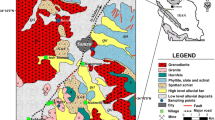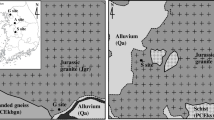Abstract
In order to assess the relationship between chemical weathering indices and physical properties of granite, physical and chemical analyses were performed on both natural and artificially weathered granite samples from the Seoul area, where the pH of the rainfall occasionally drops to below 5. The results suggest that slake durability, uniaxial compressive strength, Ruxton ratio, Parker index, modified weathering potential index, chemical alteration index and loss on ignition effectively revealed changes of the degree of chemical weathering. However, the study showed no such good correlation between chemical and physical properties except dry density against loss on ignition and modified weathering potential index against uniaxial compressive strength. It is recommended that both physical and chemical indices should be used for the classification of weathering grade for the granites in the Seoul area.
Résumé
Afin d’évaluer les relations entre les indices d’altération chimique et les propriétés physiques de granites, des analyses physiques et chimiques ont été réalisées à la fois sur des échantillons de granite naturellement ou artificiellement altéré. Ces échantillons proviennent de la région de Séoul, où le pH de l’eau de pluie descend parfois au-dessous de 5. Les résultats d’analyse suggèrent que les variations de degré d’altération chimique sont effectivement révélés par les valeurs d’indices d’altérabilité, de résistance à la compression simple, du ratio de Ruxton, de l’indice de Parker, de l’indice modifié du potentiel d’altération, de l’indice d’altération chimique et de perte au feu. Cependant l’étude n’a pas montré de véritable corrélation entre les propriétés chimiques et physiques, excepté pour les relations densité sèche et perte au feu d’une part, indice modifié du potentiel d’altération et résistance à la compression simple d’autre part. Il est recommandé d’utiliser à la fois les indices physiques et chimiques pour la détermination du degré d’altération des granites de la région de Séoul.







Similar content being viewed by others
References
Anonymous (1990) Tropical residual soils. Geological Society Working Party Report. Q J Eng Geol 23:1–102
Dearman WR, Irfan TY (1978) Assessment of the degree of weathering in granite using petrographic and physical index tests. In: Proc Int Symp on Deterioration and Protection of Stone Monuments, UNESCO, Paris, Paper 2.3
Ebuk EJ, Hencher SR, Lumsden AC (1990) Determination of residual bond strength by the pulling test method. In: Proc 6th Int Congr International Association of Engineering Geology, Amsterdam, vol. 1, pp 357–362
Fitzner B (1988) Porosity properties of naturally or artificially weathered sandstones. In: Proc 6th Int Congr on Deterioration and Conservation of Stone, Torun, pp 236–245
Franklin JA, Chandra R (1972) The slake durability index. Int J Rock Mech Min Sci 9:325–342
Hamrol A (1961) A quantitative classification of the weathering and weatherability of rocks. In: Proc 5th Int Conf on Soil Mechanics and Foundation Engineering, Paris, vol. 2, pp 771–774
Harnois L, Moore JM (1988) Geochemistry and origin of the Ore Chimney Formation, a transported palaeoregolith in the Grenville province of southern Ontario, Canada. Chem Geol 69:267–289
Hencher SR, Martin RP (1982) The description and classification of weathered rocks in Hong Kong for engineering purposes. In: Proc 7th South-east Asian Geotechnical Conf, Hong Kong, vol. 1, pp 125–142
Iliev IG (1967) An attempt to measure the degree of weathering of intrusive rocks from their physico-mechanical properties. In: Proc 1st Int Congr International Society of Rock Mechanics, Lisbon, vol. 1, pp 109–114
Irfan TY (1996) Mineralogy, fabric properties and classification of weathered granites in Hong Kong. Q J Eng Geol 11:233–244
Irfan TY, Dearman WR (1978a) The engineering petrography of a weathered granite in Cornwall, England. Q J Eng Geol 11:233–244
Irfan TY, Dearman WR (1978b) Engineering classification and index properties of a weathered granite. Bull Int Assoc Eng Geol 17:79–90
Irfan TY, Powell GE (1985) Engineering geological investigations for foundations on a deeply weathered granitic rock in Hong Kong. Bull Int Assoc Eng Geol 32:67–80
Jayawardena U De S, Isawa E (1994) Application of present indices of chemical weathering for Precambrian metamorphic rocks in Sri Lanka. Bull Int Assoc Eng Geol 49:55–61
Kaye CA (1957) The effect of solvent motion on limestone in solution. J Geol 65:35–46
Kim SS, Park HD (1999) A study on the change of rock properties using artificial weathering test. J Korean Inst Min Energy Resour Eng 36:141–149
Lumb P (1965) The residual soils of Hong Kong. Geotechnique 15:180–194
Malomo S (1980) Abrasive pH of feldspars as an engineering index for weathered granite. Bull Int Assoc Eng Geol 22:207–211
Matsuo S, Nishida K (1968) Physical and chemical properties of decomposed granite soil grains. Soils Found 8(4):10–20
Matsuo S, Nishida K, Yamashita S (1968) Weathering of the granite soils and its influence on the stability of slopes. Mem Fac Eng Kyoto Univ 30(2):85–93
Moye DG (1955) Engineering geology for the Snowy Mountains Scheme. J Inst Eng Aust 27:281–299
Nesbitt HW, Young GM (1982) Early Proterozoic climates and plate motions inferred from major element chemistry of lutites. Nature 299:715–717
Parker A (1970) An index of weathering for silicate rocks. Geol Mag Nov, 501–504
Reiche P (1943) Graphic representation of chemical weathering. J Sediment Petrol 13:58–68
Roaldset E (1972) Mineralogy and geochemistry of Quaternary clays in the Numedal area, southern Norway. Nor Geol Tidsskr 52:335–369
Rocha-Filho P, Antunes FS, Falcao MFG (1985) Quantitative influence of the weathering degree upon the mechanical properties of a young gneiss residual soil. In: Proc 1st Int Conf on Geomechanics in Tropical Lateritic and Saprolitic Soils, Brasilia, Publ 1, pp 281–294
Ruxton PP (1968) Measures of the degree of chemical weathering of rock. J Geol 76:518–527
Suoeka T, Lee IK, Huramatsu M, Imamura S (1985) Geomechanical properties and engineering classification for decomposed granite soils in Kaduna district, Nigeria. In: Proc 1st Int Conf on Geomechanics in Tropical Lateritic and Saprolitic Soils, Brasilia, Publ 1, pp 175–186
Tugrul A, Gurpinar O (1997) The effects of chemical weathering on the engineering properties of eocene basalts in northeastern Turkey. Environ Eng Geosci 3:225–234
Uriel S, Dapena E (1978) Influence of weathering on the mechanical properties of granitic rocks. In: Proc 3rd Int Congr International Association of Engineering Geology, Madrid, Section 2, Publ 1, pp 91–104
Vogel DE (1973) Precambrian weathering in acid metavolcanic rocks from the Superior Province, Villebond Township, south central Quebec. Can J Earth Sci 12:2080–2085
Vogt T (1927) Sulitjelmefeltets geologiog petrografi. Nor Geol Tidssk 121:1–560
Weinert HN (1964) Basic igneous rocks in road foundations. National Institute of Road Research Bulletin, Pretoria, South Africa, Publ 5, pp 1–47
Acknowledgements
This study was supported by the Ministry of Science and Technology in Korea (Project no. M6-0105-00-0053, 02-A01-00-043-00) and Research Institute of Engineering Science, Seoul National University.
Author information
Authors and Affiliations
Corresponding author
Rights and permissions
About this article
Cite this article
Kim, S., Park, HD. The relationship between physical and chemical weathering indices of granites around Seoul, Korea. Bull Eng Geol Environ 62, 207–212 (2003). https://doi.org/10.1007/s10064-003-0192-7
Received:
Accepted:
Published:
Issue Date:
DOI: https://doi.org/10.1007/s10064-003-0192-7




